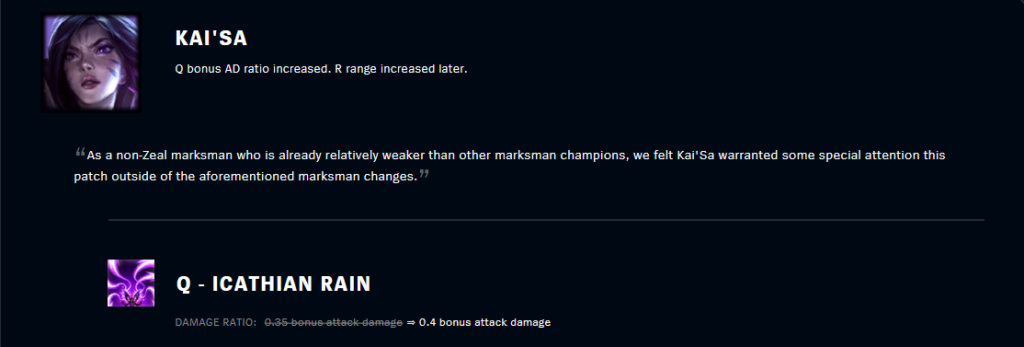I love patch notes. I believe that most other game designers love patch notes too, but if you’re someone who doesn’t care about patch notes, you probably will be confused by all this.
For awhile there’s been this idea floating around that Riot, the developers of League of Legends, have been issuing arguably-unnecessary balance changes just to keep the game “fresh” (i.e. not solved in terms of the character “meta” and related strategies). Every month or so, a bunch of characters get stronger, a bunch of others get weaker, and so on, as is the case in the latest patch notes. Riot denies that this is what they do, and I’m quite sure that it is their belief, at least, that their objective is to “head towards perfection”, as lead designer Greg Street said in my interview with him.
I believe it is their conscious desire to not simply change things just for the sake of making solution a moving target. As a point of comparison, CCGs rather explicitly embrace the “moving target” strategy, of changing the cards that are legal to play with for a certain period of time, by adding content constantly, and so on. These are changes which should be called “update patches”—updating the set regularly, and keeping the game “fresh”.
Do strategy games need to be “updated”, though? Or do they need to be upgraded? Are all of these champion buffs, month after month, for years, really upgrading the game? Riot has better data than I do, so it’s hard for me to argue about whether the game is actually made better or worse with Kai’sa’s Q doing 0.4 attack damage instead of 0.35 (Maybe it should actually be 0.37999). What I can say is that it kind of could be either thing
Update? Or Upgrade?
Today I’d like to talk about the difference between an update patch, which “brings a game up to date” in some way, and an upgrade patch, which “improves a game”. Most of the patches you find in most videogames (or board games, to the extent that they get patches or new editions) are some mix of updates and upgrades. Let’s distinguish between the two.
Updates tend to be small, regular, expected, “bringing the game current”. Updates also tend to be regular. Good strategy games, generally speaking, don’t need to that kind of “updated”; at least, not usually in terms of their ruleset. Perhaps their applications, components or components should be updated, in some way. A lot of board games have culturally insensitive, racist, or colonial themes and if second editions came out that updated that to a more “up to date” way of looking at the world, that would be a positive thing. Certainly if a game is packaged in an application form (as is the case in digital strategy games), the application may need to be updated to support new hardware or operating system changes.
But generally speaking, strategy games rulesets do not need to be “brought up to date”, I don’t think. Or at least, if they do, it’s on a much longer time scale: they certainly don’t need updates every year, and probably don’t need them every decade either.
What strategy games tend to need are upgrade patches. With the example of League of Legends, things like the new Elemental Dragons, or the randomly spawning jungle plants, or the new runes systems: these aren’t “updates”. It is actually weird to use the word “update” to describe a massive change that adds a huge amount of map input randomness to a game that previously had none. Like, they could have just never done these new Dragons or these new plants. These were specific, creative decisions that were made because the designers felt that this changed the game in a way that improves it.
Sometimes, a “second edition” of a tabletop game is a good example of an “upgrade patch”. The third edition of Puzzle Strike introduced the -$1 Combines and a bunch of other balance changes and improvements to characters. To me, that was a massive upgrade, and calling it up “update” actually feels a little bit of an understatement.
Conclusion
An upgrade changes the game with the intent of making it better. An update also intends to make the game better, but in a more obvious, automatic sort of way (as in “updating the roster” in a new NFL game, or “updating the weather” on your weather app).
Also, “updates” are maybe forever. You could always add more metagame features, replay systems, map creation thingies, collectibles, etc.
Updates are like, “ok, yeah sure I’ll download this update.” Upgrades are like “ooh, this is exciting! A game I love just got an improvement!”
Since upgrade patches involve creativite decisions, they’re a lot more risky. It is not uncommon for an intended “upgrade” patch to actually make stuff worse. This can happen with update patches, too, but usually it’s more minor (and it doesn’t have the added irony of being this braggy assertion of how much better it is). An update is always actually an update: this is the “up to date” version of the game that we’re making. So that’s safer language. I might still use the term “update patch” in my games, I’m not sure. It’s also probably worth mentioning that upgrade patches could be said to be a subset of update patches, so “update” is the safer term.
But I think the distinction between the two things is useful when thinking about what strategy game designers should be valuing, and how they should be thinking about updates to their game. Maybe it’s worth asking yourself when making a change, is this really an upgrade? Or just an update? Or perhaps, once in awhile, maybe no patch at all!
If you enjoyed this article, visit www.patreon.com/keithburgun and become a patron! Thanks for reading!

You must be logged in to post a comment.